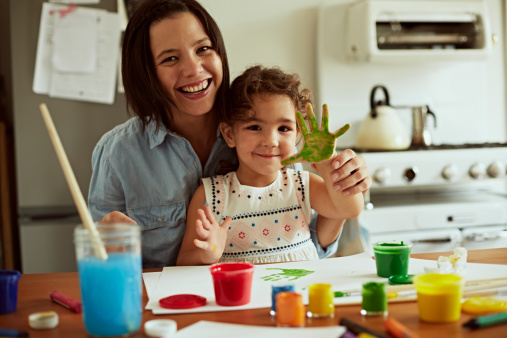Coping skills are the tools and strategies that individuals use to deal with stressful situations or emotions. These skills are essential for children to learn, as they will face many challenges and difficulties throughout their lives. As a parent, it is crucial to teach your child how to develop and use coping skills effectively. In this article, we will discuss breathing exercises, relaxation techniques, and other helpful strategies that you can use to teach your child coping skills.
1. Breathing Exercises
Breathing exercises are a powerful tool for managing stress and anxiety. When children feel overwhelmed or anxious, they may experience shallow, rapid breathing, which can exacerbate their symptoms. Teaching your child deep breathing exercises can help them calm down and regulate their breathing, leading to a reduction in stress and anxiety.

There are many different breathing exercises that you can teach your child, but one simple and effective technique is called “belly breathing.” To teach your child this technique, have them lie down on their back with a hand on their belly. Instruct them to take a slow, deep breath through their nose, allowing their belly to rise as they inhale. Then, have them exhale slowly through their mouth, allowing their belly to fall. Repeat this exercise for several minutes, or until your child feels more relaxed and calm.
2. Progressive Muscle Relaxation
Progressive muscle relaxation is a technique that involves tensing and relaxing different muscle groups in the body. This technique can help your child become more aware of physical sensations, reduce muscle tension, and promote relaxation. To teach your child this technique, have them lie down on their back and close their eyes. Instruct them to tense a specific muscle group, such as their fists or shoulders, for a few seconds before releasing the tension and relaxing the muscles. Move on to the next muscle group, repeating the process until all of the major muscle groups have been targeted.
Progressive muscle relaxation can be a helpful tool for children who struggle with anxiety, stress, or hyperactivity. By helping your child become more aware of their physical sensations, they can learn to better regulate their emotions and reactions. Here are some additional tips for teaching your child progressive muscle relaxation:
1. Start with the Basics
Before beginning the exercise, explain to your child what they will be doing and why. This can help them feel more comfortable and engaged in the process. Use age-appropriate language to explain the benefits of progressive muscle relaxation, such as reducing stress and promoting relaxation.
2. Create a Calm Environment
To maximize the effectiveness of progressive muscle relaxation, it is important to create a calm and peaceful environment. Turn off any distractions, such as phones or televisions, and dim the lights if possible. Consider playing soft music or using aromatherapy to create a relaxing atmosphere.
3. Practice Regularly
Like any new skill, learning progressive muscle relaxation takes practice. Encourage your child to practice the technique regularly, such as before bed or during times of stress. This can help them develop a habit of using this technique to manage their emotions.
4. Be Patient
It is important to be patient with your child as they learn this technique. Some children may struggle with focusing or becoming frustrated when they do not feel immediate results. Encourage your child to continue practicing, even if they do not see immediate improvement.
5. Adapt the Technique
Depending on your child’s age and individual needs, you may need to adapt the technique to make it more engaging or effective. For younger children, consider making the exercise into a game or incorporating stuffed animals or other toys. For older children, encourage them to focus on their breathing as they tense and release each muscle group.
3. Visualization
Visualization is a technique that involves imagining a peaceful or calming scene in your mind. This technique can help your child reduce stress and anxiety by redirecting their thoughts to a more positive and calming place. To teach your child this technique, have them close their eyes and imagine a place that they find calming and peaceful, such as a beach or a forest. Instruct them to visualize the details of the scene, including the colors, sounds, and smells. Encourage them to stay in this peaceful place for a few minutes, or until they feel more relaxed.

To teach your child this technique, start by having them find a quiet and comfortable place where they won’t be interrupted. Have them sit down or lie down, and close their eyes. Encourage them to take a few deep breaths and relax their body. Then, ask them to imagine a place that they find calming and peaceful, such as a beach, a forest, or a meadow.
Instruct your child to visualize the details of the scene, including the colors, sounds, and smells. Encourage them to use all of their senses to make the scene as vivid as possible. For example, if they imagine a beach, ask them to visualize the blue sky, the white sand, the sound of waves crashing, and the smell of saltwater. If they imagine a forest, ask them to visualize the green leaves, the sound of birds chirping, and the smell of pine trees.
Encourage your child to stay in this peaceful place for a few minutes, or until they feel more relaxed. Remind them that they can come back to this place whenever they feel overwhelmed.
4. Positive Self-Talk
Positive self-talk is a technique that involves using positive, encouraging words and phrases to help children manage stressful situations. This technique can help your child feel more confident and capable when facing challenges. To teach your child this technique, encourage them to use positive self-talk when they encounter difficult or stressful situations. For example, if your child is struggling with a difficult task, have them say to themselves, “I can do this,” or “I am capable and strong.”
Here are some additional tips for teaching your child positive self-talk:
- Model Positive Self-Talk
As with most skills, children learn by example. Modeling positive self-talk can help your child learn how to use this technique in their own life. When facing a challenging situation, use positive self-talk out loud so your child can hear it. For example, if you’re feeling stressed, say something like “I can handle this” or “I am strong and capable.” Your child will see that positive self-talk is a helpful tool for managing stress and anxiety.
- Use Age-Appropriate Language
When teaching your child positive self-talk, it’s important to use language that they can understand. Younger children may benefit from simpler phrases like “I can do it” or “I am brave.” As children get older, you can introduce more complex phrases that emphasize resilience and self-confidence.
- Encourage Your Child to Practice
Positive self-talk is a skill that requires practice to become effective. Encourage your child to practice using positive self-talk regularly, even when they’re not feeling stressed or anxious. You can make it a fun activity by creating positive affirmation cards with your child or having them create their own list of positive phrases.
- Celebrate Small Victories
When your child uses positive self-talk to overcome a challenge, celebrate their success with them. This can help reinforce the importance of positive self-talk and motivate them to continue using it in the future.
- Be Patient
Remember that developing positive self-talk is a process that takes time and patience. Don’t get discouraged if your child doesn’t immediately take to this technique. Keep encouraging them and providing positive feedback, and over
5. Mindfulness
Mindfulness is a technique that involves focusing on the present moment and paying attention to your thoughts, feelings, and surroundings without judgment. This technique can help your child become more aware of their emotions and thoughts, leading to a reduction in stress and anxiety. To teach your child mindfulness, encourage them to focus on their breath and observe their thoughts and feelings without judgment. You can also practice mindfulness activities with your child, such as mindful breathing, mindful eating, or mindful walking.

6. Exercise
Regular exercise is an effective way to reduce stress and promote overall well-being. Physical activity can help your child release tension, improve their mood, and increase their energy levels. Encourage your child to engage in physical activities that they enjoy, such as running, swimming, or playing sports.
Encouraging your child to engage in physical activities can also provide a sense of accomplishment and help them develop important social skills. For example, participating in team sports can help your child learn how to work with others, communicate effectively, and build positive relationships.
It’s important to remember that exercise doesn’t have to be intense or time-consuming to be effective. Even short bursts of activity, such as a quick walk around the block or a game of tag in the backyard, can provide immediate stress relief and promote overall well-being.
Incorporating physical activity into your child’s daily routine can be a fun and effective way to help them develop coping skills that will benefit them for a lifetime. Whether it’s through team sports, dance classes, or simply playing outside, encouraging your child to stay active can help them manage stress, improve their mood, and lead a happier, healthier life.
7. Creative Activities
Creative activities, such as drawing, painting, or writing, can be a great way for children to express themselves and manage their emotions. Encourage your child to engage in creative activities that they enjoy, as these activities can help them relax and reduce stress.

Creative activities can also improve their coping skills. When children engage in creative activities such as drawing, painting, or writing, they are often able to focus their minds and reduce feelings of stress and anxiety. These activities can also help children develop problem-solving skills and improve their ability to handle difficult situations. Encourage your child to explore their creativity through different mediums and provide them with the tools and materials they need to express themselves. By engaging in creative activities regularly, your child can develop important coping skills that will serve them well throughout their lives.
8. Social Support
Having a strong social support system can also help children cope with stress and difficult situations. Encourage your child to spend time with family and friends with who they feel comfortable talking to about their problems. This can help them feel supported and understood, which can reduce feelings of stress and anxiety.
Encourage your child to participate in group activities or clubs that align with their interests, as this can help them develop social connections and build coping skills. By participating in group activities, your child can learn important social skills such as communication, teamwork, and problem-solving. These skills can help them develop resilience, which is essential for coping with stress and difficult situations. Additionally, group activities can help your child feel a sense of belonging, which can improve their self-esteem and overall well-being.
9. Time Management
Teaching your child time management skills can also help them cope with stress and anxiety. When children feel overwhelmed by tasks or deadlines, they may experience stress and anxiety. Teaching your child to prioritize tasks, break them down into smaller, manageable steps, and set realistic goals can help them manage their time more effectively and reduce stress.

10. Model Coping Skills
Finally, one of the most important ways to teach your child coping skills is by modeling these skills yourself. Children often learn by observing their parents’ behavior, so if you can model effective coping skills, your child is more likely to adopt these skills themselves. This can involve using deep breathing techniques when you feel stressed, engaging in regular exercise, or talking to friends or family members when you are feeling overwhelmed.
Conclusion
In conclusion, teaching your child coping skills is an essential part of helping them manage stress and difficult situations throughout their lives. By teaching your child breathing exercises, relaxation techniques, positive self-talk, mindfulness, exercise, creative activities, time management, and social support, you can help your child develop the skills they need to manage stress and thrive. Remember to model these skills yourself, as children often learn by example. With patience, practice, and persistence, you can help your child develop the coping skills they need to lead a happy, healthy life.

